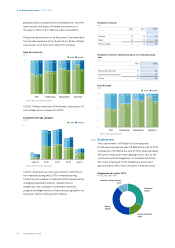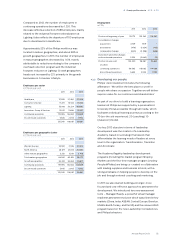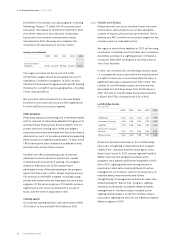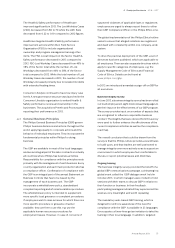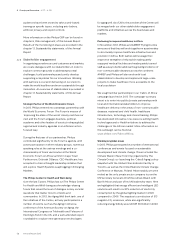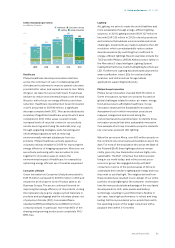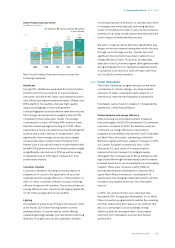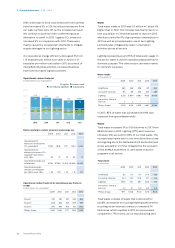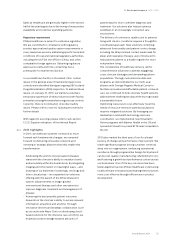Philips 2013 Annual Report Download - page 63
Download and view the complete annual report
Please find page 63 of the 2013 Philips annual report below. You can navigate through the pages in the report by either clicking on the pages listed below, or by using the keyword search tool below to find specific information within the annual report.
4 Group performance 4.3.1 - 4.3.1
Annual Report 2013 63
Green Innovation per sector
in millions of euros ■-Healthcare_■-Consumer Lifestyle
■-Lighting_■-Group Innovation
600
400
200
0
2009
50
61
185 44
340
2010
60
56
230 46
392
2011
85
67
291 36
479
2012
136
70
325 38
569
2013
80
75
327 27
509
Healthcare
Philips Healthcare develops innovative solutions
across the continuum of care in collaborating with
clinicians and customers to improve patient outcomes,
provide better value, and expand access to care. While
doing so, we take into account all Green Focal Areas
and aim to reduce environmental impact over the total
lifecycle, with a focus on energy efficiency and dose
reduction. Healthcare investments in Green Innovation
in 2013 amounted to EUR 80 million, a significant
decrease compared with 2012. This can be attributed to
a number of significant Healthcare projects which were
completed in 2012. Other areas covered include
increased levels of recycled content in our products,
remote servicing and closing the materials loop, e.g.
through upgrading strategies, parts harvesting and
refurbishing programs as well as reducing
environmentally relevant substances from our
products. Philips Healthcare actively supports a
voluntary industry initiative (COCIR) for improving the
energy efficiency of imaging equipment. Moreover, we
are actively partnering with care providers to look
together for innovative ways to reduce the
environmental impact of healthcare, for example by
optimizing energy efficient use of medical equipment.
Consumer Lifestyle
Green Innovation at Consumer Lifestyle amounted to
EUR 75 million compared to EUR 70 million in 2012 and
resulted in an increase in Green Product sales in all
Business Groups. The sector continued its work on
improving the energy efficiency of its products, closing
the materials loop (e.g. by using recycled materials in
products and packaging) and the voluntary phase-out
of polyvinyl chloride (PVC), brominated flame
retardants (BFR) and Bisphenol A (BPA) from food
contact products. In particular, more than 80% of the
shaving and grooming products are completely PVC/
BFR-free.
Lighting
At Lighting, we strive to make the world healthier and
more sustainable through energy-efficient lighting
solutions. In 2013 Lighting invested EUR 327 million in
line with EUR 325 million in 2012 to develop products
and solutions that address environmental and social
challenges. Investments are made to advance the LED
revolution, which can substantially reduce carbon
dioxide emissions (by switching from inefficient to
energy-efficient lighting). Recent examples include the
TLED and the Philips LUXEON Altilon product family in
the Mercedes S-class Intelligent Lighting System,
making this the first car in which all lighting functions are
LED. Furthermore, Lighting has developed solutions for
water purification, solar LEDs for rural and urban
locations, and LED solutions for agricultural
applications supporting biodiversity.
Philips Group Innovation
Philips Group Innovation invested EUR 27 million in
Green Innovations, spread over projects focused on
global challenges related to water, air, waste, energy,
food and access to aordable healthcare. Group
Innovation deployed the Sustainable Innovations
Assessment tool in which innovation projects are
mapped, categorized and scored along the
environmental and social dimension to identify those
innovation projects that drive sustainable innovation.
One example of a Group Innovation project is related to
low cost solar-powered LED lighting.
When the sun sets in Africa, over 600 million people on
the continent rely on kerosene and candles to see in the
dark. For most of the population who are at the Base of
the Pyramid (BoP) these lighting solutions remain
costly, give only low illumination and are highly non-
sustainable. The BoP comprises four billion people
living in our world today, and in the poorest socio-
economic group. We engaged directly with BoP
consumers in some of the poorest areas of Africa to
understand their needs for lighting and energy and how
they wish to use that light. The insights derived from
these studies have resulted in a re-design of our entire
portfolio of solar lighting for the consumer. At the same
time the new products take advantage of the very latest
developments in LED, solar panels and battery
technology, resulting in a portfolio that is flexible in
use-case, has a high performance, is robust and long
lasting. All this is provided at price-points that match
the spending power of the target consumers with a
payback time within 3-6 months.



